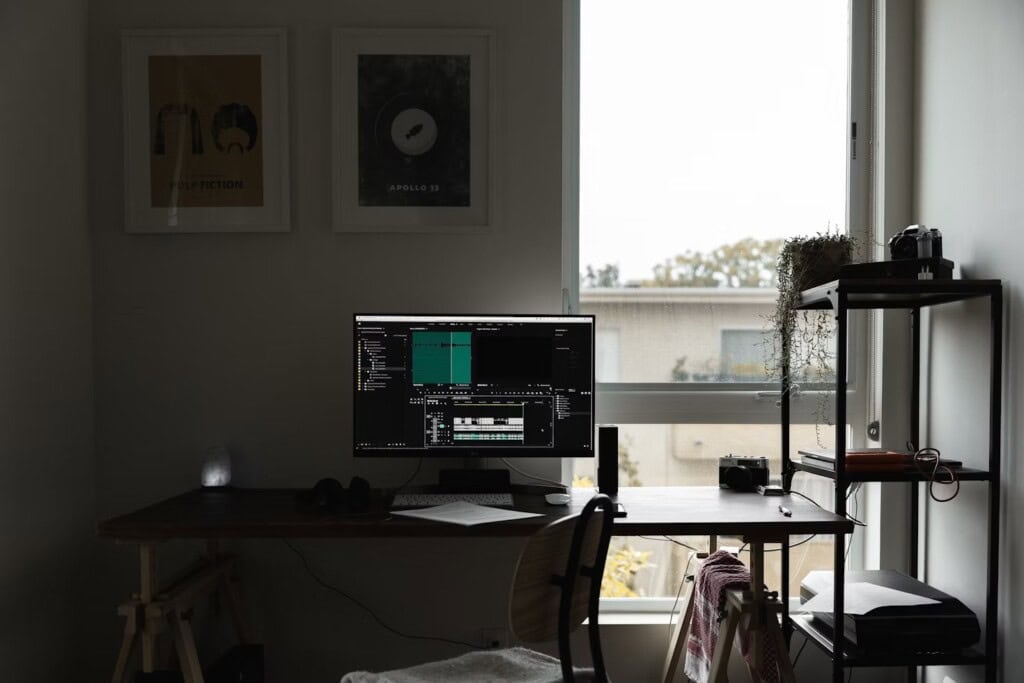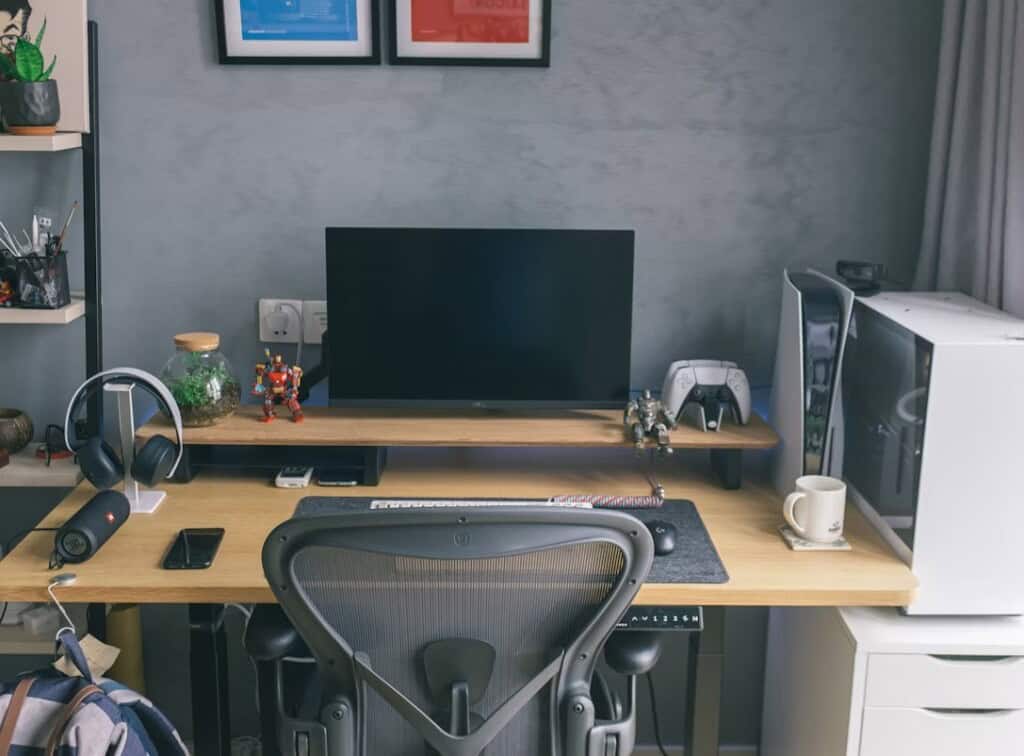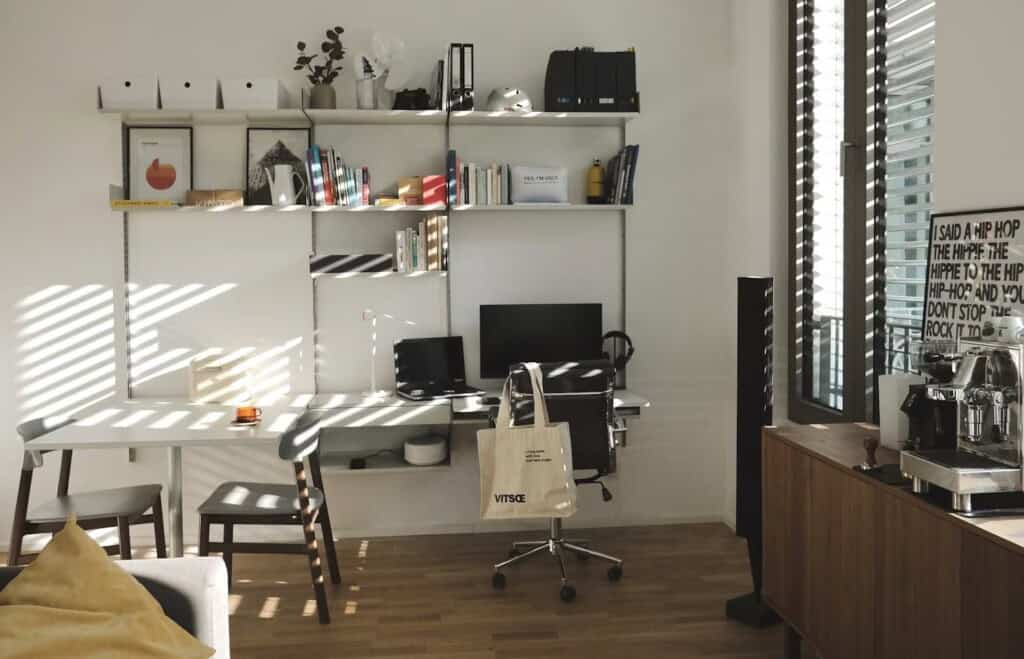
As remote work becomes more common, having a dedicated, well-thought-out workspace is essential. While some may think that creating an effective home office setup requires a significant investment, that’s not necessarily the case. With careful planning and smart choices, you can establish a productive and comfortable workspace without overspending.
A good home office setup and desk setup can make a world of difference in your daily routine, improving both your productivity and overall well-being. Investing in the right equipment and making thoughtful decisions about your workspace creates an environment that current setup supports your work style and needs.
Whether you have a spare room or just a corner of your living area, this guide will help you create the best home office setup on a budget. Our goal is to guide you through the process of building an effective home office setup with some home office setup ideas without breaking the bank.
Assessing Your Space and Needs
Before shopping for furniture and equipment, evaluate your current environment and identify a dedicated workspace. This could be a spare room, a corner of your living room, or even a shared area. Defining a productive workspace helps mentally separate work and personal life, making it easier to stay focused and create a space feel that enhances your productivity.
Consider the following factors when setting up your workspace:
- Noise levels: A quiet environment is ideal for tasks that demand high concentration.
- Natural lighting: Good lighting is necessary for virtual meetings.
- Access to power outlets.
- Potential distractions: If you’re in a busy household, try to find a spot where you can minimize background noise and interruptions.
Maximize the layout of your workspace with dual monitors to enhance both comfort and productivity.
Visually separating your workspace can be achieved with inexpensive options like curtains, bookshelves, or rearranging furniture. Functional furniture, such as corner desks and wall-mounted shelves, can help utilize smaller spaces effectively. Finally, ensure your workspace is clutter-free to maintain focus and boost productivity.
Choosing a Desk That Fits Your Budget and Space
You don’t need to invest in a full office desk for your home office. Consider the following options and tips:
- Affordable desk options are available from major retailers or local sellers.
- Alternatives like repurposed tables or wall-mounted fold-out desks can be just as effective.
- Evaluate your available space and ensure the desk fits comfortably in your home environment.
Consider the following factors when selecting a desk:
- Size: Compact desks are ideal for smaller spaces, allowing for functionality without sacrificing room for movement.
- Sturdiness
- Storage features: Built-in storage options, such as drawers and shelves, can help keep your workspace organized and clutter-free.
- Height adjustable desk: Height-adjustable desks can promote better posture and circulation, allowing users to alternate between sitting and standing.
DIY desk ideas using sawhorses and a tabletop or second-hand furniture can be a budget-friendly solution for the crafty. Consider the following when selecting or making a desk:
- Laminate desks are often more affordable and practical, providing a stain-resistant surface suitable for frequent use.
- Check the desk dimensions before purchase to prevent issues with fitting the desk in your designated space.
- Some desks come with built-in cable management systems to reduce clutter and keep cords organized.
Finding a Comfortable Chair Without Overspending

A comfortable chair is essential for long-term health and comfort while working from home. Ergonomics play a crucial role in preventing back pain and other health issues. Look for budget-friendly models that offer decent support, such as the Branch Ergonomic Chair and ergonomic furniture, which provides various adjustments and a sleek design.
When choosing a chair, make sure it has:
- Adjustable armrests to ensure proper ergonomic support, allowing your wrist pain to remain straight during use.
- Proper lumbar support to maintain the natural curve of your spine and prevent back pain while seated.
- A seat height that allows your feet to be flat on the floor, with knees positioned at a 90 to 100-degree angle.
If you already have a chair but it lacks ergonomic features, consider the following alternatives:
- Using ergonomic cushions or lumbar pillows
- Using exercise balls or kneeling chairs as temporary seating solutions
- Checking local marketplaces or office liquidations for used chairs in good condition
Lighting Considerations for Focus and Mood
Lighting plays a significant role in productivity and mental well-being. Natural light is the best source of illumination, so try to place your desk near a window to maximize it. Proper lighting can influence factors like mood and alertness, making it an essential element of your home office setup.
When natural light isn’t enough, affordable artificial lighting options can be helpful, such as:
- LED desk lamps with brightness and color adjustments
- Task lighting that provides adequate brightness for focused work without causing eye strain
- Energy-efficient lighting options, like LED bulbs, which can reduce energy costs while providing effective illumination.
Adding indirect lighting or warm bulbs can reduce eye strain and create a more comfortable environment. Here are some lighting considerations for your home office setup:
- Warm colors like yellow and orange are more conducive to relaxation and social interactions.
- Cooler blue lights can enhance focus and concentration.
- Good lighting improves the appearance and clarity on video calls, making it an important consideration.
Laptop vs. Desktop Setup: Making the Right Choice
Most remote workers can start with what they have, typically a reliable laptop. Laptops are prized for their portability, allowing users to work without being tethered to a power outlet.
Enhance your laptop screen setup by connecting a portable monitor, portable monitors, external monitor, external display, wireless keyboard, and mouse for better ergonomics and multitasking while working remotely. Budget options for used or refurbished computer monitor and accessories can be found online.
For those needing more computing power, desktops generally provide superior performance due to their ability to house more powerful hardware. Upgrading components is significantly easier in desktops, as users can access internal parts directly.
Cost-wise, desktops often offer better value for performance, allowing users to get more powerful setups for less money than comparable laptops.
While desktops are stationary and require a dedicated workspace, laptops can easily be transported and stored away, making them ideal for users with limited space.
Battery life can be a significant drawback of laptops, as varying performance can limit usability when not plugged in. For students and those with limited space, laptops are typically preferred due to their compact size and portability, and using laptop stands can enhance ergonomics.
Improving Audio for Calls and Meetings
Clear audio is essential for virtual meetings. Relying solely on built-in laptop microphones and speakers can result in poor audio quality and distracting background noise. Investing in dedicated noise canceling headphones with a microphone offers better clarity and reduces background noise, enhancing both professional communication and listening comfort.
For off-call audio like music or podcasts, portable Bluetooth speakers and computer speakers are a worthwhile, budget-friendly upgrade. They can improve overall ambiance and focus in a home office environment.
Affordable Organization Tools and Cable Management

A tidy workspace improves focus and reduces stress. Low-cost organization hacks like using drawer dividers, DIY cable clips, or small boxes for supplies can help keep your desk space organized. Vertical organization solutions such as pegboards or wall shelves can maximize valuable desk space and keep your workspace clutter free workspace.
Repurposing household items for storage is a great way to save money. For example:
- Using small containers or jars to hold office supplies can keep your workspace tidy and efficient.
- Cable management solutions like Velcro ties, bins, and cable management clips help keep cords organized and easy to access.
- Smart storage options like self-adhesive cable clips can secure frequently-used cables to surfaces for easy reach.
Digital organization tools can also help declutter your mental workspace. Many productivity tools offer free versions that include essential features for remote work, such as task management and collaboration.
Productivity-Boosting Software That’s Free or Cheap
Using the right software tools can be just as valuable as physical upgrades. Many productivity tools offer free versions that include essential features for remote work, such as task management and collaboration. Open-source tools can be a great budget-friendly alternative for productivity software.
Some popular free productivity software includes Trello for project management and Slack for team communication. Cloud-based applications often provide free tiers that allow for team collaboration and file sharing without cost. Browser extensions or automation tools can simplify repetitive tasks and enhance overall workflow efficiency.
Incorporating these tools into your work routine creates a more productive and comfortable workspace. Whether you’re managing multiple projects, communicating with your team, or organizing your tasks, there are plenty of budget-friendly software options to help you stay productive.
Health and Wellness Considerations in Your Setup
Sitting all day and poor posture can lead to health issues. Incorporate movement into your workday with standing breaks or stretching routines to maintain physical well-being. Inexpensive solutions like resistance bands, under-desk pedals, or foam rollers can help you stay active throughout the day.
Budget-friendly standing desk converters are a great way to add movement into your routine without a significant investment. These converters can be placed on top of your existing desk, allowing you to alternate between sitting and standing. Low-cost wellness items like anti-fatigue mats or blue-light-blocking glasses can also improve your comfort and reduce strain while working.
Establishing a morning routine and setting fixed work hours can enhance productivity and help manage personal time effectively. Taking regular breaks is crucial for maintaining focus and reducing fatigue throughout the long hours of the workday.
Adding Personality to Your Space Without Spending Much
Your workspace should reflect your style and create an environment you enjoy. Personalizing your space doesn’t have to be expensive. Here are some budget-friendly options to add personality to your workspace:
- Photos
- Art prints
- Houseplants
- Desk decor
- Shopping at thrift stores
- Using printable decor
DIY accessories can enhance the aesthetic of your home office while adding warmth and texture. Some ideas include:
- Custom window treatments or pin boards
- Thrifted frames and inexpensive prints from public domain artworks to create a personalized gallery wall
- Incorporating plants to add a lively touch and improve air quality
Consider seasonal updates or rearranging decor to refresh your workspace without spending much.
Soundscaping for Focus and Mood
Ambient sound can significantly affect concentration and relaxation. Creating a soundscape with:
- white noise
- nature sounds
- instrumental music can enhance your work environment. Biophilic soundscapes, which incorporate nature-based sounds, have been shown to boost productivity more effectively than complete silence.
Portable Bluetooth speakers are a compact, cost-effective way to deliver clear sound for both work and leisure. Different individuals have varying sensory preferences, so it’s important to tailor soundscapes to accommodate your needs. Using music platforms and apps that offer curated playlists for focus or relaxation can help you stay focused and maintain a deep focus during work.
Sourcing Smart: Where and How to Shop on a Budget
Finding the best deals for home office gear can make a significant difference in your budget. Online marketplaces such as:
- Facebook Marketplace
- Craigslist
- OfferUp are great places to find gently used furniture and tech at a fraction of the cost. Browsing these platforms can yield fantastic deals on desks, chairs, and other office essentials.
To find the best bargains on office supplies, consider the following strategies:
- Use price comparison tools or set alerts for sales.
- Take advantage of seasonal sales events.
- Subscribe to newsletters from office supply stores to receive exclusive deals and promotions.
Refurbished electronics are another budget-friendly option. Many refurbished items come with warranties, ensuring you get a reliable product at a lower price. Joining local Buy Nothing groups or coworking forums can also be beneficial for finding giveaways or getting advice on where to shop for budget-friendly office equipment.
Conclusion: Small Investments, Big Impact
Creating a comfortable, productive work-from-home setup doesn’t require luxury purchases. Focusing on essentials first can make a huge difference in your work environment, such as:
- A proper desk
- An ergonomic chair
- Good lighting
- Clear audio Small, intentional changes can significantly enhance how you work and feel at home.
Affordable upgrades like earphones with a microphone and portable Bluetooth speakers are examples of high-impact, low-cost additions that can improve your home office setup. Don’t forget to personalize your space to reflect your style and create an environment you enjoy. A welcoming workspace boosts morale and motivation, helping you stay productive and comfortable.
Remember, you can continue refining your setup over time. Adjust your workspace as your needs evolve to ensure it remains functional and inspiring.
Frequently Asked Questions
Should I choose a laptop or a desktop for my home office setup?
Choosing between a laptop and a desktop comes down to your needs and space. If you want portability and work in a tight area, a laptop is great; but for better performance and value, a desktop is the way to go.
How can I improve audio quality for virtual meetings?
To improve audio quality for virtual meetings, consider investing in dedicated earphones with a microphone for clearer sound and reduced background noise. This simple upgrade can make a big difference in your call experience!
What are some budget-friendly ways to personalize my workspace?
Personalizing your workspace doesn’t have to break the bank—try adding photos, art prints, or houseplants for a touch of you. Thrift stores and printable decor are great ways to find budget-friendly pieces that really make the space your own!
Where can I find affordable office furniture and equipment?
You can find affordable office furniture and equipment on online marketplaces like Facebook Marketplace, Craigslist, and OfferUp for gently used items. Don’t forget to check for seasonal sales and refurbished electronics with warranties for even more savings!
What are some free or cheap productivity tools for remote work?
Trello for project management, Slack for team communication, and Google Workspace for collaboration are great free tools to boost your remote work productivity. These will definitely help streamline your tasks and improve communication with your team!


